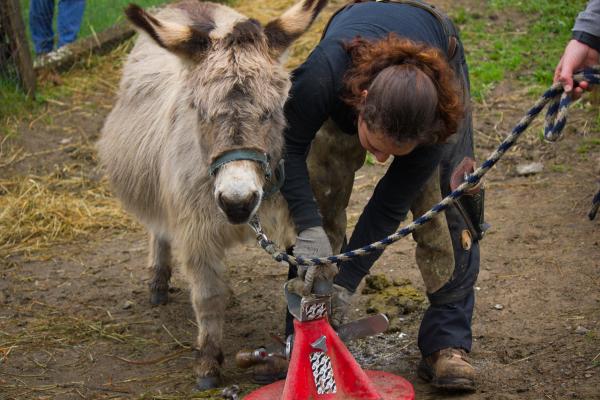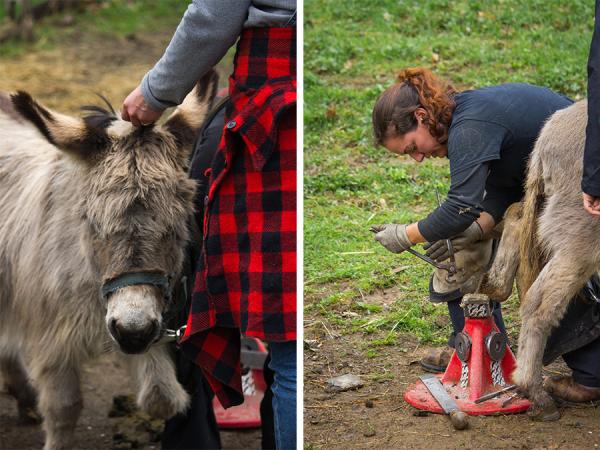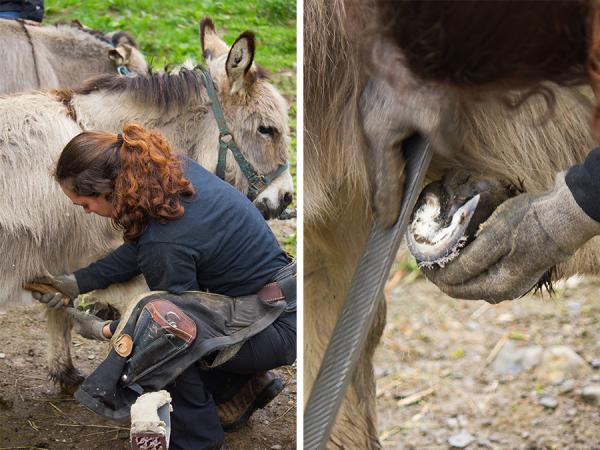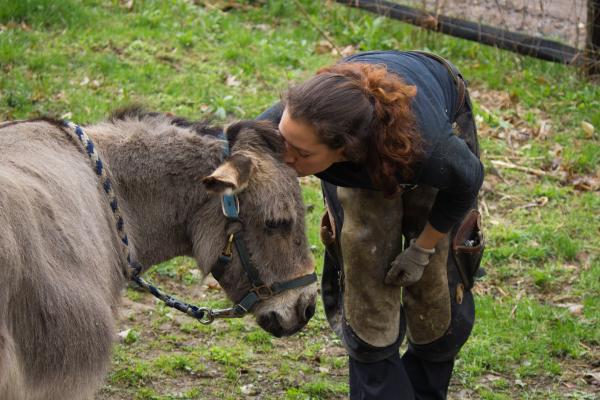I loved this article! I will share it with my equestrian daughter--fascinating info conveyed in an informative, user-friendly and fun manner.
Hoofcare in the Farmyard
Even though our Farmyard animals have retired from their working years, their hooves still need looking after. Every four to five weeks, farriers Annie and Jeremiah of Common Ground Hoofcare come to the Farm to care for Zeke’s hooves (a retired draft horse) and Dudley and Penelope’s hooves (two miniature Sicilian donkeys). We asked Annie and Jeremiah a few questions to understand more about the work of a farrier.
Why doesn't Zeke or the donkeys need to wear shoes?
Annie: Zeke and the donkeys don't require shoes because their jobs are light in the Farmyard: they mostly are standing, grazing, and looking adorable! If they were asked to do more, they may need protection or support for a more strenuous job. Zeke is also blessed with very solid, healthy feet, so unless he was being asked for a lot of very hard work (or needed other advantages, like traction), his feet are very functional while bare.
How did you become a farrier?
Annie: I have horses of my own and started trimming in an effort to be self-sufficient. I ended up loving hooves, and soon realized I wanted a more formal education in order to help more animals. I spent two years with a farrier in Pennsylvania working and studying intensely.
Jeremiah: I tripped on a horseshoe one day and, at the age of eleven, somehow ended up being the youngest student to graduate the farrier program that was based out of the farm where I took riding lessons.
Do all equines require the same foot care?
Annie: All equines require the same base foot care; that is, routine trimming every four to six weeks. Whether or not they get that is a different story…
However, some require more care. Pathologies such as laminitis and founder, navicular disease, certain bony changes, chronic infections, and the like require more involved foot care, including booting, therapeutic shoeing, or other routine maintenance.
Zeke is an older, retired draft horse who has some arthritis. What special care does he require to keep his feet healthy and his body comfortable?
In my mind, horses with arthritic changes, or just simply old joints, do best when they have as compact a foot as possible while maintaining soundness. Keeping Zeke’s hooves from growing excessively long makes it easier to articulate his joints around his big feet, encourages him to stand with proper posture, and to have a good relationship with gravity. Proper posture helps him expend less energy while standing and moving, reducing unnecessary wear and tear on his body.
Donkeys are very tough, hardy creatures, and their natural foot is much stronger and hardier than the average horse. Even hard-working donkey feet seem to require less protection than most horses.
Our equines at the farm vary greatly in their size. Is it easier trimming Zeke's hooves or our miniature donkeys, Dudley and Penelope's, hooves?
That’s a very funny question! Many people will ask if we give discounts for minis. However, I practice yoga for a variety of reasons, one of them being the need to bend myself into all sorts of pretzel-like shapes to work around tiny mini legs and bodies. For whatever reason, many miniatures, whether donkeys or horses, seem to be wigglier than the average horse, so now we are holding onto wiggle-monsters while getting into a pretzel shape.
Draft horses can be a challenge simply because they are HEAVY. The best-behaved horses tend to lean onto farriers while we work on their feet: they’re generally taught to move into pressure, hence their pulling talents. Thankfully, Zeke is an absolute gentleman, and tries to balance himself while standing on three legs.
The donkeys and Zeke are all very kind to work on, and make the size difference funny, as opposed to challenging.
How often is it necessary to trim barefoot equines and why?
Jeremiah and I keep our client horses on a four- to five- week cycle. We feel this is the most beneficial length cycle to stay ahead of any distortions in the hoof capsule, which includes problems such as flares, cracks, and thrush infections.
Overgrown hooves can lead to the aforementioned problems, and also create excess stress on the equine’s joints and lamina of the foot (the lamina being the connective tissue that holds the foot to the bone).
When a horse’s toes become long in front of their limb, it becomes difficult for the animal to simply get its foot off the ground. Long toes also affect their posture, and their relationship with gravity, which can create compensatory problems in their body, such as low back pain, unbalanced hoof growth, and the eventual breakdown of tendons and ligaments.
It all starts at their feet, or as the saying goes in the equine world, “no hoof, no horse!”
Comments
I loved this article! I will share it with my equestrian daughter



